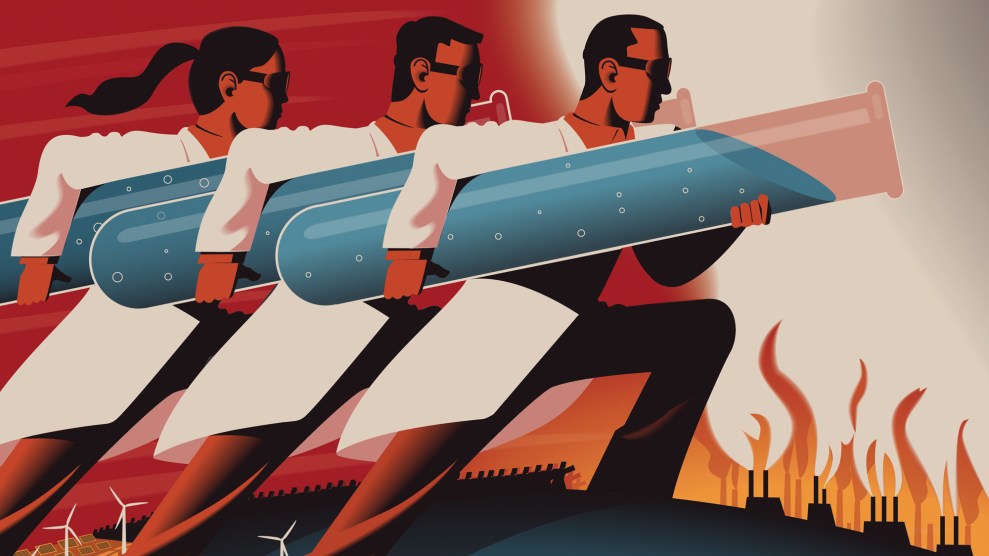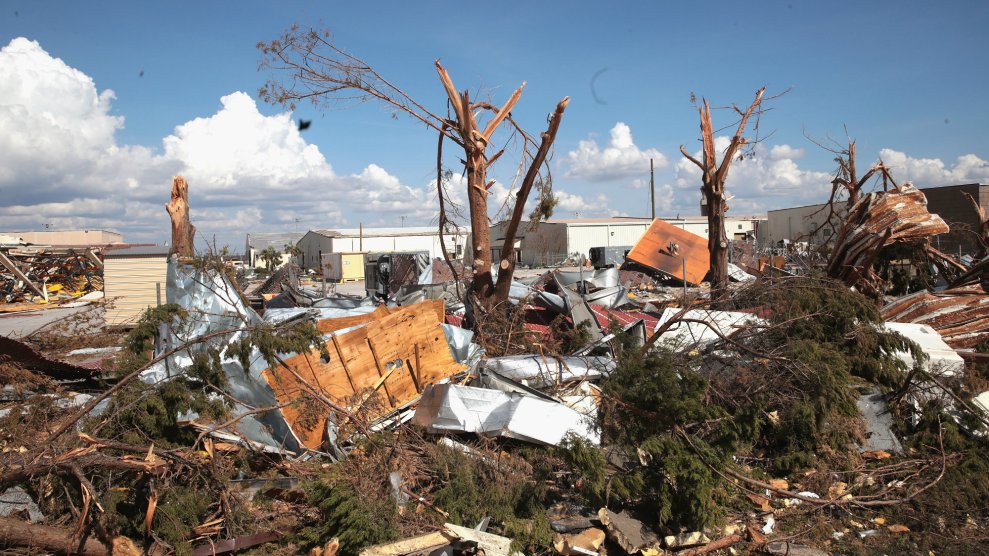
Irfan Khan/Los Angeles Times/Getty
The US military has spent decades cultivating a corrosive environmental legacy around the world. Just last December, about 6,000 people became sick when jet fuel from a World War II-era Navy storage facility reportedly leaked into the drinking water aquifers of Hawaiian residents. Famously, at North Carolina’s Camp Lejeune military base, up to 1 million people were exposed to contaminated drinking water over the course of 25 years. And on military bases constructed for America’s post-9/11 wars, trash was often destroyed in burn pits that contained everything from computers to furniture to medical waste that released toxic smoke, breathed in by soldiers and civilians alike.
But while many people may be familiar with the stories of these environmental disasters, the massive carbon emissions produced by the military’s day-to-day operations have received comparatively little attention.
Neta C. Crawford, a political scientist at Oxford University, aims to fix that in her new book, The Pentagon, Climate Change, and War: Charting the Rise and Fall of US Military Emissions. Although the Pentagon has been at the forefront of climate change research since the mid-20th century, Crawford writes, the US Department of Defense is also the single largest institutional fossil fuel user in the world. Since 2001, the military has been responsible for 77 to 80 percent of federal energy consumption.
The DOD maintains more than 560,000 buildings on about 500 bases around the world, making up a large portion of its emissions. And like a goliath multinational corporation, it relies on an extensive network of fossil-fueled ships, trucks, planes, and other vehicles to support its operations—from dropping bombs to delivering humanitarian aid—all of which makes the military a key contributor to climate change. And although recent research has demonstrated that the US military is one of the largest polluters in history, it still tends to be overlooked in climate change studies.
Crawford’s book tries to fill this gap in the research, chronicling how the US military got caught in a long-term cycle of economic growth, fossil fuel use, and dependency. I hopped on a call with her to learn more.
What inspired you to write this book about the scale of the US military’s carbon footprint?
I’ve been working on war since the 1980s, but my class on climate change that I’ve been teaching for a few years, “Interdisciplinary Perspectives on Global Challenges: Climate Change,” was a source of inspiration. I had a lecture where I wanted to just put some information on greenhouse gas emissions on a slide and I couldn’t find it easily. This started me along the path of finding out about the US military’s carbon footprint. I wanted to contextualize it, but that information wasn’t available, so I had to do some research. I ended up writing a small paper about military emissions for the Costs of War Project, of which I am co-director, which is an initiative by Brown University that analyzes the implications of the post-9/11 wars in Iraq and Afghanistan, and the related violence in Pakistan and Syria in terms of human casualties, economic costs, and civil liberties. And that paper was my initial calculation of US military emissions and some discussion of its relationship to the post-9/11 wars. This book is a much larger exploration, both historically and strategically, of thinking about US military-industrial emissions.
Give us a sense of the scope of US military emissions for someone who’s not familiar with this topic.
The US military is the largest user of fossil fuels and energy in the US government. US military emissions are about 51 million metric tons, CO2 equivalent, annually in the last two years. This is a reduction from past military emissions, but still larger than the emissions of most countries. That does not include the emissions caused by the destruction of property—the burning of infrastructure, including cities—that the US may engage in when they make war. Annual US DOD emissions are about 1 percent of US total emissions. If you add military-industrial emissions, I estimate military and military-industrial emissions [from domestic industries that make weapons and equipment] are about 2 percent of total US emissions.
Can you elaborate on this paradox of the Pentagon being one of the first institutions to acknowledge climate change and yet remaining the single largest institutional consumer of fossil fuels in the world?
Yes. It’s not only that the Pentagon has acknowledged climate change—they heavily funded the research in the 1950s and 1960s that was instrumental in identifying the mechanisms for global warming. Institutionally, they have an older understanding of climate change than most of the US government. And in terms of the paradox, there are two parts to that.
First, the Pentagon looks at the world in terms of threats—but it doesn’t see its own role in increasing greenhouse emissions as part of the problem. It also works very hard to reduce emissions, but its reductions of emissions are not at the most fundamental level. And US military doctrine has not changed to take into account the fact that Persian Gulf oil has been a decreasing source of oil input for the United States, and overall, petroleum use has declined. So, we’ve got the same military doctrine in a changing world, but this military doctrine leads to greenhouse gas emissions.
The United States has been very concerned with making sure that its military doctrine focuses on securing access [to oil]. And that’s by providing military equipment and money to regional allies, having bases and personnel there, and maintaining its capacity to move military forces quickly to the region, in order to protect access to oil. So that doctrine has essentially not changed since the late 1970s, early 1980s.
What’s something surprising you learned from your research?
I knew a little bit about the ways the United States military and the Department of Defense had tried to keep greenhouse gas emissions by the military out of the 1997 Kyoto Protocol counting process so that it would not be part of the national emissions reporting. But I learned through the release of classified documents that happened last year, and through further research, that it was a very sustained and influential effort, so the depth of their effort surprised me.
Additionally, I learned that the US dependence on coal in the 19th century parallels and precedes the US dependency on oil. The necessity of, for example, getting bases in Hawaii to be sure to have coal deposits that one can put into ships, precedes or parallels the US’s interest in having bases overseas for oil. By going back to the 19th century, I understood much better how we got the infrastructure of the bases and installations that we have today and how closely they were related to the necessity, or perceived necessity, of having access to fuel to make war or to power US economic interests.
I was struck by your argument that, were it not for the post-9/11 wars, the downward trend in military emissions that we saw after the Cold War would likely have continued.
Following the end of the Cold War, the United States was transitioning away from coal, and closing military bases that were no longer necessary—this was part of the “base realignment enclosure process,” which is the congressionally authorized process the Department of Defense has used to reorganize its base structure to be more efficient and effective. There were several rounds of base realignment enclosure, so military bases decreased from 2,000 bases back then to roughly 800 bases today.
So, there’s been a decline in the footprint of the military institution. It’s dangerous to have your forces be so tethered to fuel lines and communication. If a tank runs out of fuel in the middle of an operation, that puts people at risk. You’re having to transport fuel across long lines of communication where there are potentially hostile people, and that’s worrisome and it also puts people at risk. We’ve seen that there’s been increased interest in efficiency because of that vulnerability, and trends in wanting greener fuel and decreasing the size of the military because it wasn’t needed any longer to fight a Soviet threat increased efficiency, leading to a decline in overall emissions by the US military at the time. But of course, following 9/11, fuel use increased, and therefore emissions grew.
You make an interesting point that the United States’ grand strategy for national security is premised on the anticipation and fear of war. Can you elaborate on this?
Every military is concerned about that—that’s their job. The point I’m trying to make is that potential war, let’s say with Russia or China, or any other possible adversary, is just that—it’s possible. Climate change is certain. And we know that it’s on the way. In preparing for this possible eventuality, we’re taking resources away from dealing with the certain facts of the need to reduce military emissions. Preparing for climate change-caused war is counterproductive because it takes away resources for mitigation—that is, emissions reductions—and adaptation that could reduce the likelihood of a climate-change caused war. Historically, when resources are scarce, societies often find ways to adapt and cooperate. Climate-change caused war is also not inevitable. It’s possible, but it doesn’t have to occur.
You also write about breaking the cycle of militarization and emissions as one of the most important things governments can do to make a more peaceful world possible. But the size and reputation of the American military is such a significant part of national identity. How might one pitch the public on the idea of reducing our standing military?
That is a problem with people fearing that they’ll be labeled as soft on whatever the threat of the era is, and potentially leaving the United States unprepared for an attack. But the US military is very capable of meeting almost every threat—I think it’s even capable of meeting all threats. I think that what we’ve learned from the war in Ukraine is that it’s possible for a well-trained, civilian-based force, along with some professional military, to stop a superpower. What I argue is that we have been overspending and over-insuring against first, the Soviet threat, and now the Russian threat. And what we’re doing right now by pivoting toward China is causing, I believe, the Chinese to respond by increasing their military capability. And we’re increasing our military capability because they’re showing greater economic interest in the Persian Gulf and Africa. China has one military base. We’ve got hundreds of military bases overseas. But this rivalry doesn’t have to be a military rivalry. We’re making it that way, and they increase their military emissions as they respond to what social scientists call the “security dilemma,” that is, what one entity does to defend itself, protect itself, may be perceived as aggressive by the other, and then you get into this cycle of action and reaction. And this is the road to how overall US military emissions can potentially keep increasing.
The Pentagon seems to have this vision of becoming a “lean green fighting machine,” as you put it. Can you tell me how you think it falls short in its current efforts?
The US military can change their posturing in the Persian Gulf by reducing the standing military forces there—the thousands of people that they have ready at all times, the aircraft carrier that they’ve got going with at least 10 associated ships at all times, all ready to defend access to this Gulf oil that, in fact, we shouldn’t use, because it’s going to kill us to keep pumping greenhouse gasses into the atmosphere at the rate we are. Aircraft are the largest greenhouse gas emitters within the operational emissions of the US military, so they could make changes in fuel type, to biofuels. But more important than fuel type, from my perspective, is rethinking the American geopolitical postures. Do we need to be in those places flying those planes, operating those ships, and having those people transported there on a more-or-less permanent basis at all?
Did you face any problems or challenges when researching and writing this book?
I think the major obstacle for me was the lack of transparency and manually doing the math as a result, since the numbers were not publicly available. If we don’t have the numbers, we can’t have this conversation about the US military’s greenhouse gas emissions. The military is clued into the fact that they’re the largest petroleum user in the US. It’s clear that they know that. Congress has required that they disclose their numbers now, thank goodness, and people like me hopefully won’t have to keep doing these calculations. Other people have made estimates, but they’ve made them for a single year, or a single period of war, but it’s very important that we have the big picture so that we can understand the trends.
I think it’s interesting that fuel use declined steadily beginning in 1975 and then went up, and how that tracks war. Now, sure, you’d expect that, but this book actually shows it. The thing that’s important for public discourse is for us to have this basic information, and I’m really grateful that Congress is requiring it through the most recent National Defense Authorization Act.
This interview has been edited and condensed.
Correction, October 10: An earlier version of this story misstated Neta C. Crawford’s institutional affiliation.











